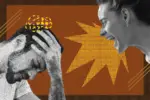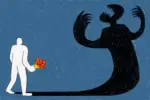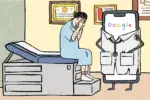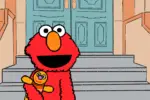Mental health awareness has been growing in recent years as many try to reduce the stigma surrounding mental illness. At the same time, rates of mental illness have continued to increase, with both adults and children experiencing anxiety, depression and other ailments. While treatments have become more accessible, we still lack quality portrayals of what it is like to suffer from a mental illness — especially when it manifests in chronic physical symptoms. Luckily, Raina Telgemeier has taken a step to remedy this problem with her graphic novel “Guts.”
“Guts” tells the true story of Telgemeier’s own childhood experience trying to manage anxiety and its physical manifestations. The novel begins when young Raina comes down with a stomach bug. She recovers quickly and soon returns to school, but her stomach aches persist, and she has difficulty trying to understand what is happening in her body. At the same time, Raina develops new worries and fears that seem to go hand in hand with her physical ailments.
The story follows Raina as she struggles to identify her triggers and manage her anxiety and stomach pain — all while facing the inevitable growing pains of childhood. As Raina’s symptoms worsen, she also must contend with tensions among family and friends, fifth-grade bullies and the confusing effects of puberty.
While Telgemeier covers a lot of ground, the story never feels directionless or heavy-handed. On the contrary, her ability to focus on her own personal experience while giving voice to the universal challenges of growing up makes “Guts” an authentic representation of mental health. Before reading “Guts,” I was skeptical of its premise, as stories about characters who deal with anxiety or depression often run the risk of homogenizing the experience of mental illness. Furthermore, I doubted that a graphic novel about the author’s own life could succeed at being relatable to a larger audience. However, despite the story’s focus on young Raina’s unique circumstances, “Guts” brilliantly encapsulates the frustrations of diagnosing and managing a chronic ailment, whether it be physical or mental.
As I read “Guts,” I saw myself reflected in Raina’s experiences. When I was in middle school, a stomach bug went around my class, and I soon became fearful of anything having to do with throwing up; in the back of the book, Telgemeier explains that this fear is called emetophobia. Though I was able to manage my fear throughout high school, I found it more difficult in college as I developed anxiety that caused stomach aches. Like Raina does in the story, I went to multiple doctors trying to understand why I was feeling bad, and eventually came to the understanding that I had irritable bowel syndrome (IBS) — an illness diagnosed based on painful abdominal symptoms and notoriously difficult to treat. Raina’s doctor’s explanation that she has IBS was the first time I had seen my own experience acknowledged and normalized in the life of another character.
“Guts” gets many things right about chronic illness as it gives voice to the frustrations of diagnosis and treatment. Despite doctors telling Raina that her tests are normal and that she is “healthy as a horse,” Raina wonders, “Can you be sick even if you’re not sick? Can you be healthy even if you hurt?” The fact that Raina receives her IBS diagnosis well into the second half of the book speaks to how difficult it is to understand one’s own chronic ailment, let alone communicate the experience to others. Fittingly, “Guts” is a great starting point for those trying to understand how a loved one with chronic pain might feel.
The novel succeeds the most in its depiction of the mental effects of chronic illness, made even more compelling by Telgemeier’s engaging illustrations. As Raina’s emetophobia begins to cause stomach aches, her overall anxiety worsens. In a two-panel spread that shows Raina from the waist up, her worried face in the top panel reflects the many anxious thoughts in her mind, while the lower panel shows her torso and her various feelings. The image is simple, but powerful. It encapsulates Raina’s realization that her thoughts and her feelings are intertwined and that illness and health do not affect the mind and body separately, but impact them together.
The story remains relatable for a wider audience by focusing on Raina’s fears. While the representation of IBS is empowering for me and others who suffer from gastrointestinal disorders, Telgemeier’s portrayal of anxiety strikes a more inclusive chord. Even with Raina’s individual experience of emetophobia and elementary school drama, many of her fears are universal.
As Raina’s parents try to understand their daughter’s new struggles along with her, they schedule Raina for therapy. Raina’s first session normalizes the worries associated with therapy and its required vulnerability: When her doctor asks her why she has come to therapy, Raina begins to think about all the things she is afraid of, but fails to communicate them to her therapist. Phrases like “siblings,” “mean people” and “bad at math” emerge, represented in a greenish haze of block letters above Raina’s head. But the cloud of fears starts to grow, encompassing smaller worries as well as more profound fears like “my parents dying” and “war.”
Raina’s cloud of worries, a visual representation of how it feels to be overwhelmed by fear, speaks to how anxiety can manifest in different ways, even when certain worries are more predominant. But even though she cannot tell her therapist about all these fears right away, Raina starts to become more aware of them and understand her mind better. She soon learns ways to manage new sources of stress on her own as she addresses her more nagging troubles.
“Guts” is a therapeutic read for anyone struggling with a chronic mental or physical illness. Raina’s anxiety and IBS play a large role in her life, but she still finds moments of joy with friends and family despite her worries. And as she learns more from her doctors, therapist and parents, she gains a more nuanced perspective of both herself and other people. Ultimately, Telgemeier makes it clear that anxiety and illness do not define you and that there will always be highs amidst the lows. Dedicated to “anyone who feels afraid,” “Guts” shows that whether you’re a child with a new fear or an adult who has been battling chronic illness for years, there is hope for healing.

















